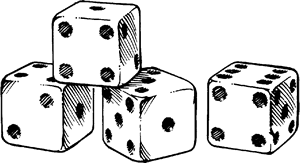Hard Dice Probability Question
 Alexi rolled four standard dice and lined them up to create a 4-digit number. He removed two dice from the line and rolled them again. Alexi then returned each re-rolled die to its original position in the line, thereby creating a new 4-digit number. The probability that the new 4-digit number is greater than the original 4-digit number can be expressed as a fraction
, where
and
are relatively prime integers. What is
+
?
Alexi rolled four standard dice and lined them up to create a 4-digit number. He removed two dice from the line and rolled them again. Alexi then returned each re-rolled die to its original position in the line, thereby creating a new 4-digit number. The probability that the new 4-digit number is greater than the original 4-digit number can be expressed as a fraction
, where
and
are relatively prime integers. What is
+
?
The answer is 107.
This section requires Javascript.
You are seeing this because something didn't load right. We suggest you, (a) try
refreshing the page, (b) enabling javascript if it is disabled on your browser and,
finally, (c)
loading the
non-javascript version of this page
. We're sorry about the hassle.
The probability that the new number is greater is equal to the probability that the new number is lesser. Let it be be A . Let the probability that the new number is same be B
2 A + B = 1
The probability B that the new number is the same is 6 1 ∗ 6 1 = 3 6 1
Solving we have A = 7 2 3 5